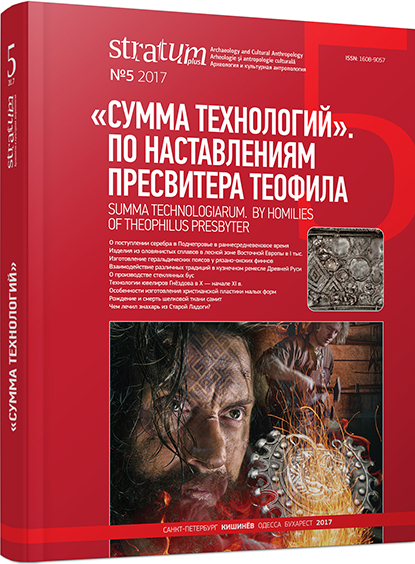О специфике изготовления изделий из Борщевского клада
Manufacturing Features Distinguished in Items from the Borschevka Hoard
Author(s): Raphael MinasyanSubject(s): History, Archaeology, Middle Ages
Published by: Издательский дом Stratum, Университет «Высшая антропологическая школа»
Keywords: Ancient Rus; Volhynia; Borsсhevka hoard; temple rings; neck-rings; lunulae pendans; filigree; soldering; wire
Summary/Abstract: The hoard was discovered in Borschevka village (Volhynia province) in 1883. It consists of 7 chopped and intact neckrings, 2 lunulae pendants with filigree, and temple-rings decorated with granulation. Lunulae pendants are particularly interesting. They differ from similar adornments their scale and the manufacturing technique. Borschevka lunulae pendants are poorly crafted; they are large, with thin supports; the wire frames, made to strengthen the work, are weak; the rows of granulation are unevenly soldered. These design defects were the reason why the adornment could be destroyed even by the slightest deformation in its supports. The plaques, wires and parts of the granulated ornament’s figures have fallen off.In Borschevka lunulae pendants, the setting of the decorative wire had not been manufactured as recommended by Theophilius, which was widespread in Western Europe and, probably, in Scandinavia as well. On the pendants, the decorative frames were fastened with thin silver wire, threaded through perforations. Afterwards, semispherical plaques were soldered on, and the wire knots with sharp ends had not been removed, but left on the reverse side. The artisan, who made these, owned very good instruments, suitable for microscopic works. The artisan knew how adornments are produced and decorated with granules of diameters of three hundred microns. But he was not good with this art and the items he produced were not of a high quality — they had not even been worn, as evidenced by the absence of traces of wearing.It is necessary to point out that the technique of filigree and granulation first appears in the finest performance in Rus only in the 10th century. Before that, this decorative technique had not been employed.
Journal: Stratum plus. Археология и культурная антропология
- Issue Year: 2017
- Issue No: 5
- Page Range: 237-245
- Page Count: 9
- Language: Russian
- Content File-PDF

